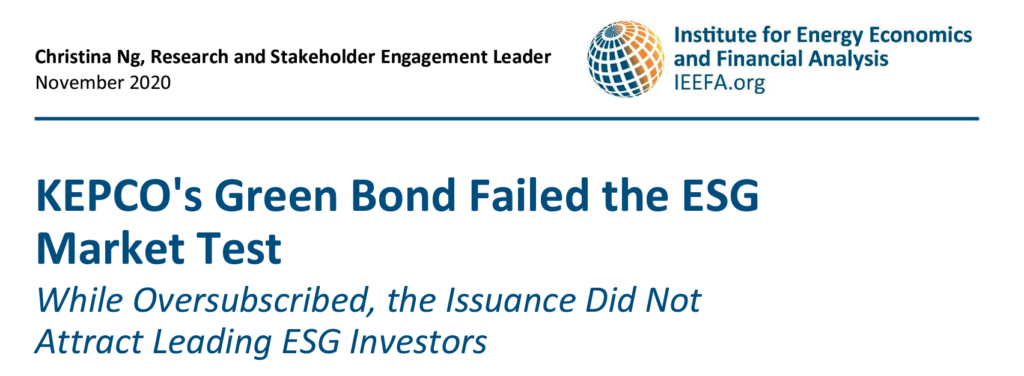Korea Electric Power Corporation’s (KEPCO’s) recent green bond failed to attract leading sustainable investors, despite being 10 times oversubscribed, according to new research by the Institute for Energy Economics and Financial Analysis (IEEFA).
The South Korean state-owned utility’s June 2020 green bond raised US$500 million from international financial investors. But IEEFA’s analysis of bondholder data reveals that many of the well-regarded environmental, social and governance (ESG) investors shunned the offering.
“Serious ESG investors are looking beyond high yields and investment grades and scrutinise a company’s overall strategy, governance and follow-through.”
– Christina Ng, Research and Stakeholder Engagement Leader at IEEFA and report author

KEPCO has come under pressure from major investors over its funding of overseas coal projects. In May 2020, notable KEPCO shareholders, including BlackRock and the Church of England, publicly urged the utility to cancel its new coal-fired power projects and demanded it establish a clearer strategic direction.
Only weeks after the green bond was issued, KEPCO confirmed it would be investing in new coal-fired power plants, Jawa 9 and 10 in Indonesia and Vung Ang 2 in Vietnam. Concerns around KEPCO’s management of ESG issues and the company’s ongoing investment in overseas fossil fuel projects are red flags for serious ESG investors. This type of investor will not fund a company’s ‘green projects’ while there are new fossil fuel projects in other parts of its business.
Following criticism over its decision to go ahead with these projects, KEPCO announced it will not pursue more new overseas coal power projects and plans to cancel or convert those remaining in its pipeline into liquified natural gas (LNG) – another fossil fuel, albeit a less carbon-intensive one. In October 2020, the company said it will exit from all overseas coal power ventures by 2050.
According to its Green Bond Framework, KEPCO says its new strategy involves “focusing its resources on creating a clean and efficient energy ecosystem as part of its effort to cut down greenhouse gas emission[s].” South Korea has committed to cutting emissions to net zero by 2050, and the wording of the Framework aligns with the country’s domestic shift toward renewable energy.
According to Ng, it’s not uncommon for investors including banks, insurers, pension funds and asset managers to invest in green bonds for common portfolio diversification, prudential risk management, or business needs. And, as with conventional bonds, the tenor and yield of green bonds are key factors that drive such investment decisions. Serious green investors, on the other hand, are thorough in their due diligence and exclude environmentally harmful companies from their portfolios.
“At first glance, KEPCO’s green bond issuance appeared to be a positive step and it was very oversubscribed, which is a reflection of the fast-growing appetite for ESG investing. But IEEFA’s research shows the green bond lacked support from serious ESG investors. KEPCO and other companies that have decided to pursue a greener business model need to work harder to demonstrate to the market that they are taking the right steps to align with ESG investors.”
– Christina Ng
